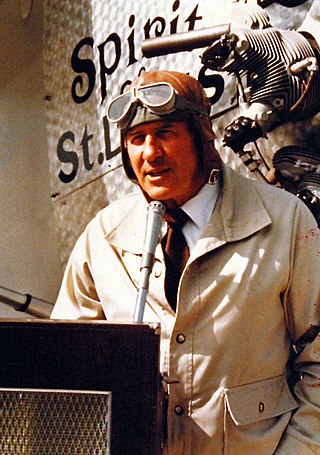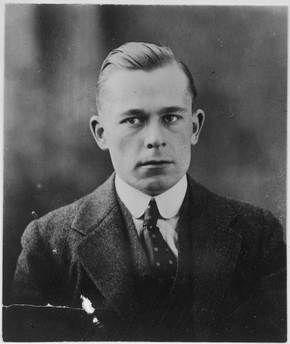Related Research Articles

Air Commodore Leonard Joseph Birchall,, "The Saviour of Ceylon", was a Royal Canadian Air Force (RCAF) officer who warned of a Japanese attack on the island of Ceylon during the Second World War.

Paul Howard Poberezny was an American aviator, entrepreneur, and aircraft designer. He founded the Experimental Aircraft Association (EAA) in 1953, and spent the greater part of his life promoting homebuilt aircraft.

Canada's Aviation Hall of Fame, based in The Hangar Flight Museum in Calgary, Alberta, Canada, commemorates and honours those whose accomplishments in aviation contributed so much to Canada's development as a nation. Founded in 1973, the Hall of Fame has honoured thus far more than 200 aviators, engineers, technicians and administrators.

General Paul David Manson was a Canadian Forces officer, fighter pilot and businessman.

Maxwell William Ward was a Canadian aviator and founder of Wardair Airlines, at one time the third-largest air carrier in Canada.

Air Commodore John Emilius Fauquier, was a Canadian aviator and Second World War Bomber Command leader. He commanded No. 405 Squadron RCAF and later No. 617 Squadron RAF over the course of the war. A bush pilot prior to the war, he joined the Royal Canadian Air Force as a flight instructor in 1939. He then joined 405 Squadron in 1941 and would fly operationally for the rest of the war, taking a drop in rank on one occasion to return to active command. During his three tours of operation he participated in Operation Hydra and dozens of other sorties over Europe.
Alfred Beebe Caywood was a Canadian aviator.

"I Can Dream About You" is a song written and performed by American singer Dan Hartman on the soundtrack album of the film Streets of Fire. Released in 1984 as a single from the soundtrack, and included on Hartman's album I Can Dream About You, it reached number 6 on the Billboard Hot 100.
Lt. Col (Ret.) Joseph Armand Gerard Fernand Villeneuve was a Canadian aviator who joined the Royal Canadian Air Force (RCAF) in 1950 and was the first leader of the RCAF's Golden Hawks aerobatic team. He flew for 32 years as a military jet fighter pilot Villeneuve was inducted into the Canadian Aviation Hall of Fame in 2006.
George Bayliss Lothian was a Canadian aviator. He was one of the first pilots of Trans-Canada Air Lines in 1937, which later became Air Canada.

Basil Deacon Hobbs, DSO, OBE, DSC was a British and Canadian aviator. He is the second most highly decorated pilot in Canada.
Walter "Babe" Woollett was a Canadian pilot who was inducted into the Québec Air and Space Hall of Fame on 26 November 2003 and Canada's Aviation Hall of Fame 2004.
Walter Frank Chmela was an Austrian-born Canadian aviator. He has set many Canadian records in the field of soaring. He has been a leading promoter of the sport of soaring in Canada.
Zebulon Lewis "Lewie" Leigh, was a Canadian aviator. He never used his first name and was always addressed as "Lewie".
Dennis Kestell Yorath, MBE was an aviator and business executive who was a Member of the Order of the British Empire for his contributions to Canadian aviation and in particular the British Commonwealth Air Training Plan during World War II.

"Second Nature" is a song by American singer-songwriter Dan Hartman, released in 1985 as the fourth and final single from his fifth studio album I Can Dream About You (1984). The song was written by Hartman and Charlie Midnight, and produced by Hartman and Jimmy Iovine. "Second Nature" reached No. 39 on the Billboard Hot 100 and remained in the charts for 12 weeks.
Moretta Fenton Beall "Molly" Reilly became the first female Canadian pilot to reach the rank of captain, the first female Canadian corporate pilot, and the first woman to fly to the Arctic professionally. Her modifications to the Beechcraft Duke were used to improve the aircraft. Over the course of her career, Reilly logged over 10,000 flight hours as a pilot-in-command — without a single accident. She is a member of the Canadian Aviation Hall of Fame.
Violet Milstead Warren was a Canadian aviator, noted for being the first female Canadian bush pilot and one of only four Canadian women to work in the British Air Transport Auxiliary (ATA) during WWII. With over 600 hours of flight time during the war, she was the longest serving female Canadian ATA pilot. She worked as a flight instructor at Barker Field in Toronto, Ontario, and her students included commercial pilot Molly Reilly and author June Callwood. She is a member of the Canadian Aviation Hall of Fame, the Order of Canada, and the Bush Pilots Hall of Fame.

Lorna Vivian deBlicquy (1931–2009) was a pioneering female Canadian aviator who flew for over 50 years, becoming Canada's first woman civil aviation flight test inspector. She contributed significantly to improve conditions for working women pilots. In 2014, she was posthumously inducted into Canada's Aviation Hall of Fame.

Stanley Ransom McMillan was a Canadian aviator.
References
- 1 2 3 "Paul Albert Hartman". collectionscanada.gc.ca.
- ↑ Pigott, Peter (July 25, 1996). Flying Canucks: Famous Canadian Aviators. Dundurn. ISBN 9781459714168 – via Google Books.
- ↑ "CAHF". cahf.ca.
- ↑ "Canada's Aviation Hall of Fame". collectionscanada.gc.ca.
- ↑ Pigott, Peter (July 7, 2016). Aviation Pioneers of Canada 7-Book Bundle: Brace for Impact / Air Canada / and 5 more. Dundurn. ISBN 9781459737228 – via Google Books.